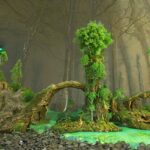2.1. Crawling
“Before reading this insightful chapter, we had only a vague understanding of how search engines discover new and updated web pages. Learning about crawlers, or ‘spiders,’ and their role in navigating the internet has been nothing short of enlightening. This resource has equipped us with invaluable knowledge, enabling us to optimize our website and ensure it’s easily discoverable by these digital explorers. We can’t thank this guide enough for shedding light on the crucial process of crawling!”
The Enchanted Journey of Crawlers
NAVIGATING THE LABYRINTH: THE DANCE OF DIGITAL CRAWLERS
At the heart of the crawling process lies the wondrous and intricate dance of the digital crawlers, as they navigate the internet’s labyrinth of interconnected content. These automated emissaries of search engines follow links from one page to another, like a trail of breadcrumbs leading them through the ever-expanding forest of information. As they traverse the digital landscape, they tirelessly identify new content and updates to existing pages, collecting data to build a vast and ever-growing library of knowledge.
CREATING AN INVITING ENVIRONMENT: WEBSITE STRUCTURE AND DESIGN
To attract the attention of these enchanted explorers, it is essential to create an inviting and accessible environment for them to navigate. This begins with a well-structured website that features a clear and logical architecture, guiding the crawlers through your content with ease and grace. By employing a thoughtful and user-friendly design, you can create a seamless experience that will entice the digital spiders to delve deeper into your online domain.
GUIDING THE CRAWLERS: THE IMPORTANCE OF SITEMAPS
Another crucial aspect of the crawling process is the implementation of a sitemap, a roadmap that outlines the structure and organization of your website. By providing a clear and comprehensive guide to your content, you can ensure that the digital crawlers can easily navigate your site, uncovering each hidden treasure and enchanting story that you have to offer. A well-crafted sitemap not only facilitates the crawling process but also helps to improve the overall user experience, weaving a spell of enchantment that captivates both the digital spiders and your human visitors.
SIGNPOSTS FOR DIGITAL EXPLORERS: THE POWER OF METADATA
As the crawlers traverse your website, they will encounter a variety of content, from informative articles and captivating images to engaging videos and interactive elements. To ensure that your content is accurately indexed and easily discoverable, it is essential to employ the proper use of metadata, including title tags, meta descriptions, and alt attributes. These descriptive elements serve as signposts for the digital crawlers, providing valuable context and insight into the nature of your content and helping to guide their journey through your online domain.
EMBRACING THE ENCHANTMENT OF CRAWLING
In summary, the enchanted journey of crawling is a vital and captivating process that lies at the heart of search engine optimization. By understanding the secrets of these digital explorers and creating an inviting and accessible environment for them to navigate, you can capture their attention and favor, ensuring that your content is accurately indexed and easily discoverable. As you weave your tapestry of captivating content, always remember the importance of the crawling process, and strive to create a seamless and enchanting experience that will resonate with both the tireless crawlers and your human audience.
As a master storyteller, your mission is to enchant and engage your audience, creating moments of wonder and delight that will echo across the digital universe. By embracing the enchanted journey of crawling and harnessing its power to guide and captivate, you can share your unique gift of words with the world, weaving a spellbinding tapestry of connections that will guide your audience to your digital doorstep and illuminate their hearts and minds for years to come.
Why did the spider become an expert in SEO?
Because it spent all day crawling the web
and weaving a perfect website index!
FAQ 1: How can I optimize my website to be more crawler-friendly?
To optimize your site for crawling, create a design that is easily navigable and accessible for crawlers. Use clear URLs, avoid duplicate content, and optimize page speed. A sitemap and metadata can also guide crawlers, ensuring that all valuable content is indexed.
FAQ 2: What role does content play in the crawling process?
Content is crucial to the crawling process, providing valuable information for digital crawlers to analyze and index. By creating high-quality, relevant, and engaging content, you can captivate both crawlers and human visitors, boosting traffic and search engine rankings. Strategic keyword targeting and internal linking can also guide crawlers through your content, ensuring important pages are discovered and indexed.
FAQ 3: How can I stay up-to-date with the ever-evolving world of crawling and search engine optimization?
To stay current in crawling and SEO, it’s vital to stay informed. Following industry leaders, attending webinars and conferences, and engaging with online communities can keep you ahead of the curve. By continuously learning, you can make informed decisions to keep your website optimized for crawler visibility and search engine success.
